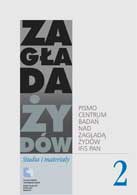Menu
- Main Page
- About us
- Research
- Publications
- Links
- Contact
- Archiwum
- Holocaust. Studies and Materials
the Center's Journal - NIGHT WITHOUT AND END - »FAILED CORRECTION«
- Wybór źródeł
- EHRI PL
News
Programme of Center's academic seminars for winter term 2025
We are pleased to announce the return of our scientific seminar series in less than a month, and warmly invite all interested parties to attend. The seminars will be held on the second or third Wednesday of each month, both in person at the Institute of Philosophy and Sociology of the Polis...
M. Turski Historical Award of Polityka for Justyna Majewska
It is with undisguised pride we report that our colleague Dr. Justyna Majewska has been awarded the Marian Turski POLITYKA Historical Prize for her book debut, "Mury i szczeliny. Przestrzenie getta warszawskiego /Walls and Slits. Spaces of the Warsaw Ghetto". We are very happy and...
Call for Articles - Holocaust Studies and Materials 2026
Call for Articles 2026 Call for Articles Connecting scholarly reflection on the Holocaust to the present - new sources and technologies in research The past decade has seen a breakthrough in Holocaust research, both in terms of the availability of archival sources and the digital ...
Farewell to Marian Turski
It is with profound sorrow that we bid farewell to Marian Turski—a distinguished journalist, historian, and Survivor. An extraordinary man whose voice resonated deeply, he not only shared the lessons of the past but actively championed courage, solidarity, and empathy in the face of evil. ...
Center in EHRI PL consortium
Polish Center for Holocaust Research of the Institute of Philosophy and Sociology of the Polish Academy of Sciences, together with the E. Ringelblum Jewish Historical Institute and the Center for Jewish Studies of the University of Lodz, are creating a national node of the European Holocaust Research Infrastructure within the framework of ERIC
NEWSLETTER
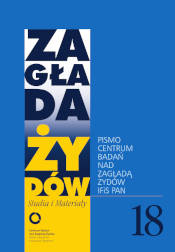 Zagłada Żydów.
Zagłada Żydów.
Studia i Materiały
nr 18, R. 2022
Warszawa 2022
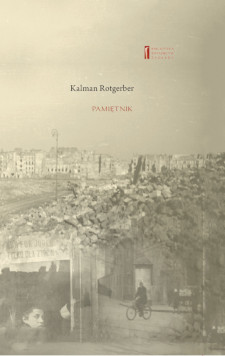 PAMIĘTNIK
PAMIĘTNIK
Kalman Rotgeber
oprac. Aleksandra Bańkowska, wstęp Jacek Leociak
Warszawa 2021
Zagłada Żydów.
Studia i Materiały
nr 17, R. 2021
Warszawa 2021
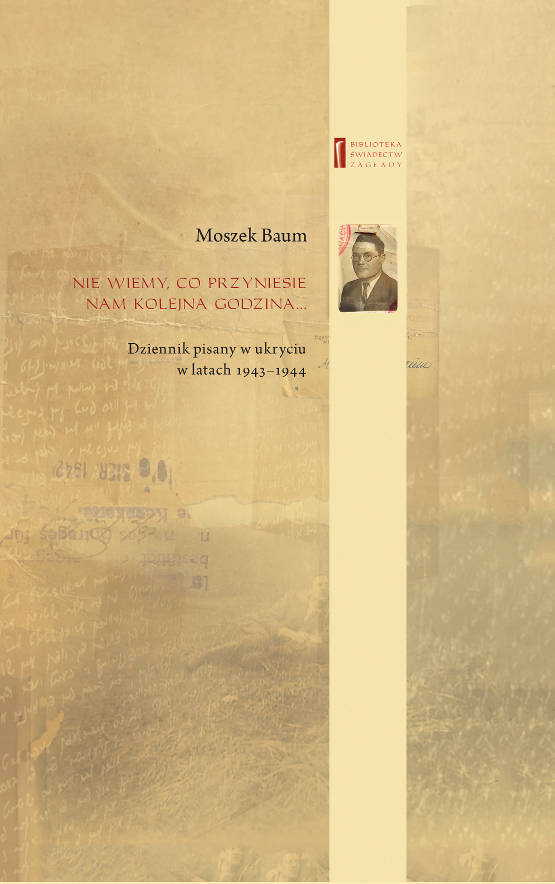 NIE WIEMY CO PRZYNIESIE NAM KOLEJNA GODZINA ...
NIE WIEMY CO PRZYNIESIE NAM KOLEJNA GODZINA ...
Dziennik pisany w ukryciu w latach 1943-1944
Moszek Baum, oprac. Barbara Engelking, tłum. z jidysz Monika Polit
Warszawa 2020
Zagłada Żydów.
Studia i Materiały
nr 16, R. 2020
Warszawa 2020
.jpg) Aryjskiego Żyda wspomnienia, łzy i myśli
Aryjskiego Żyda wspomnienia, łzy i myśli
Zapiski z okupacyjnej Warszawy
Sewek Okonowski, oprac. Marta Janczewska
 PISZĄCY TE SŁOWA JEST PRACOWNIKIEM
PISZĄCY TE SŁOWA JEST PRACOWNIKIEM
GETTOWEJ INSTYTUCJI ...
'z Dziennika' i inne pisma z łódzkiego getta
Józef Zelkowicz, tłum. z jidysz, oprac. i wstęp. Monika Polit
Warszawa 2019
CZYTAJĄC GAZETĘ NIEMIECKĄ ...
Dziennik pisany w ukryciu w Warszawie w latach 1943-1944
Jakub Hochberg, oprac. i wstępem opatrzyła Barbara Engelking
Warszawa 2019
Zagłada Żydów.
Studia i Materiały
nr 15, R. 2019
Warszawa 2019
.jpg) Zagłada Żydów.
Zagłada Żydów.
Studia i Materiały
nr 14, R. 2018
Warszawa 2018
 DALEJ JEST NOC. Losy Żydów w wybranych powiatach okupowanej Polski
DALEJ JEST NOC. Losy Żydów w wybranych powiatach okupowanej Polski
red. i wstęp Barbara Engelking, Jan Grabowski
Warszawa 2018
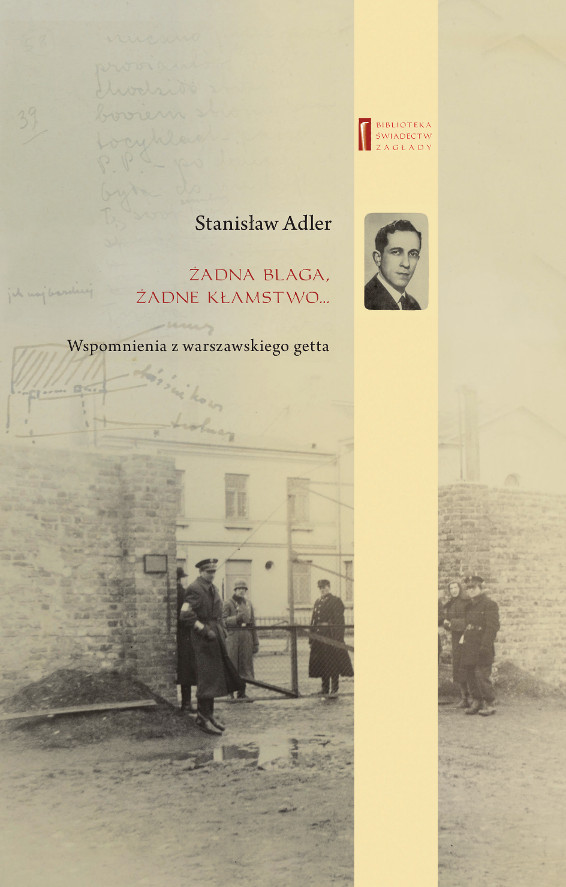 ŻADNA BLAGA, ŻADNE KŁAMSTWO ...
ŻADNA BLAGA, ŻADNE KŁAMSTWO ...
Wspomnienia z warszawskiego getta
Stanisław Adler, oprac. i wstępem opatrzyła Marta Janczewska
Warszawa 2018
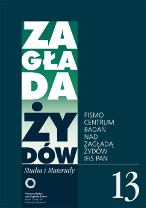 Zagłada Żydów.
Zagłada Żydów.
Studia i Materiały
nr 13, R. 2017
Warszawa 2017
 TYLEŚMY JUŻ PRZESZLI ...
TYLEŚMY JUŻ PRZESZLI ...
Dziennik pisany w bunkrze (Żółkiew 1942-1944)
Clara Kramer, oprac. i wstępem opatrzyła Anna Wylegała
Warszawa 2017
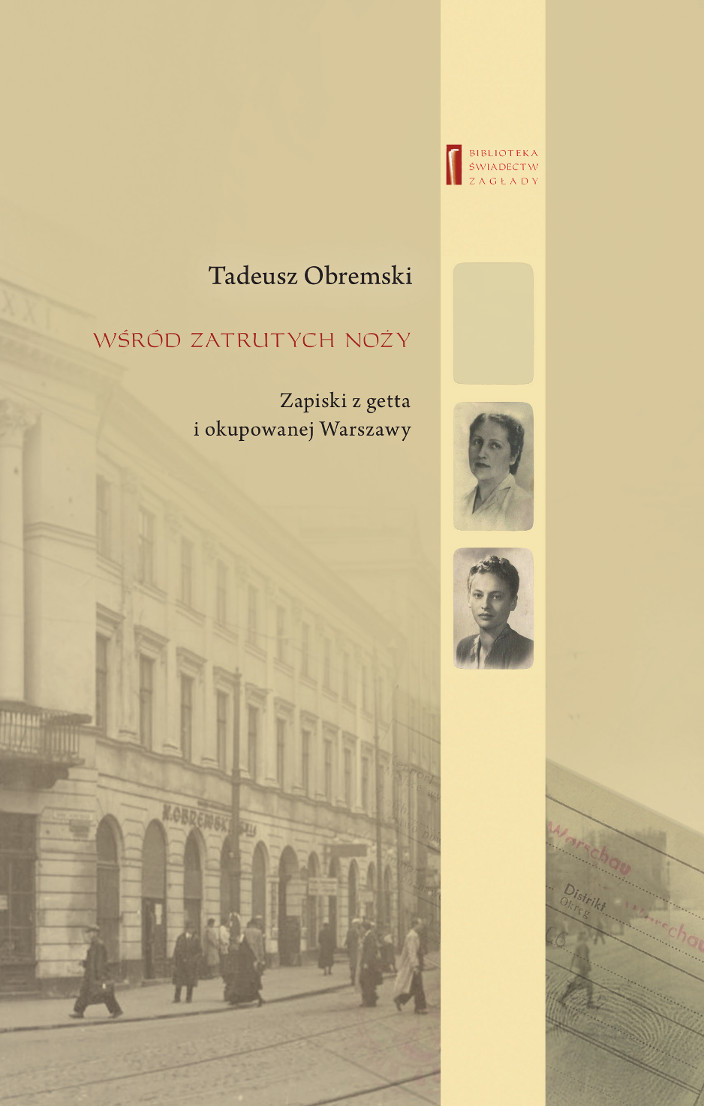 WŚRÓD ZATRUTYCH NOŻY ...
WŚRÓD ZATRUTYCH NOŻY ...
Zapiski z getta i okupowanej Warszawy
Tadeusz Obremski, oprac. i wstępem opatrzyła Agnieszka Haska
Warszawa 2017
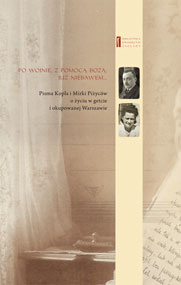 PO WOJNIE, Z POMOCĄ BOŻĄ, JUŻ NIEBAWEM ...
PO WOJNIE, Z POMOCĄ BOŻĄ, JUŻ NIEBAWEM ...
Pisma Kopla i Mirki Piżyców o życiu w getcie i okupowanej Warszawie
oprac. i wstępem opatrzyła Barbara Engelking i Havi Dreifuss
Warszawa 2017
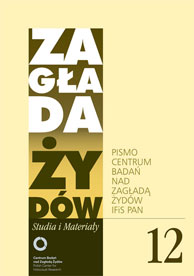 Zagłada Żydów.
Zagłada Żydów.
Studia i Materiały
nr 12, R. 2016
Warszawa 2016
.jpg) SNY CHOCIAŻ MAMY WSPANIAŁE ...
SNY CHOCIAŻ MAMY WSPANIAŁE ...
Okupacyjne dzienniki Żydów z okolic Mińska Mazowieckiego
oprac. i wstępem opatrzyła Barbara Engelking
Warszawa 2016
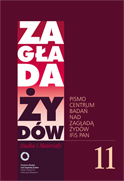 Zagłada Żydów.
Zagłada Żydów.
Studia i Materiały
nr 11, R. 2015
Warszawa 2015
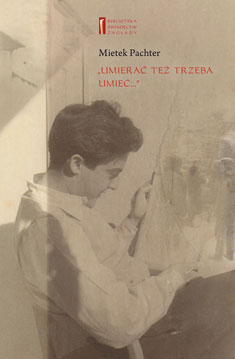 Mietek Pachter
Mietek Pachter
UMIERAĆ TEŻ TRZEBA UMIEĆ ...
oprac. B. Engelking
Warszawa 2015
 Zagłada Żydów.
Zagłada Żydów.
Studia i Materiały
nr 10, t. I-II, R. 2014
Warszawa 2015
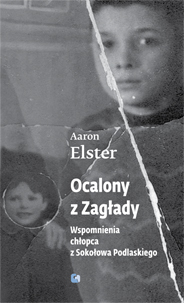 OCALONY Z ZAGŁADY
OCALONY Z ZAGŁADY
Wspomnienia chłopca z Sokołowa Podlaskiego
tłum. Elżbieta Olender-Dmowska
red .B. Engelking i J. Grabowski
Warszawa 2014
 ZAGŁADA ŻYDÓW. STUDIA I MATERIAŁY
ZAGŁADA ŻYDÓW. STUDIA I MATERIAŁY
vol. 9 R. 2013
Pismo Centrum Badań nad Zagładą Żydów IFiS PAN
Warszawa 2013
 ... TĘSKNOTA NACHODZI NAS JAK CIĘŻKA CHOROBA ...
... TĘSKNOTA NACHODZI NAS JAK CIĘŻKA CHOROBA ...
Korespondencja wojenna rodziny Finkelsztejnów, 1939-1941
oprac. i wstępem opatrzyła Ewa Koźmińska-Frejlak
Warszawa 2012
Raul Hilberg
PAMIĘĆ I POLITYKA. Droga historyka Zagłady
tłum. Jerzy Giebułtowski
Warszawa 2012
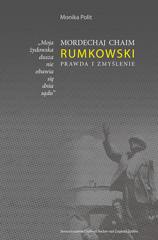 Monika Polit
Monika Polit
"Moja żydowska dusza nie obawia się dnia sądu."
Mordechaj Chaim Rumkowski. Prawda i zmyślenie
Warszawa 2012
.jpg) Dariusz Libionka i Laurence Weinbaum
Dariusz Libionka i Laurence Weinbaum
Bohaterowie, hochsztaplerzy, opisywacze. Wokół Żydowskiego Związku Wojskowego
Warszawa 2011
.jpg) Zagłada Żydów.
Zagłada Żydów.
Studia i Materiały
R. 2011, nr. 7; Warszawa 2011
.jpg) Jan Grabowski
Jan Grabowski
JUDENJAGD. Polowanie na Żydów 1942.1945.
Studium dziejów pewnego powiatu
Warszawa 2011
.jpg) Stanisław Gombiński (Jan Mawult)
Stanisław Gombiński (Jan Mawult)
Wspomnienia policjanta z warszawskiego getta
oprac. i wstęp Marta Janczewska
Warszawa 2010
Holocaust Studies and Materials
Journal of the Polish Center for Holocaust Research
Warssaw 2010
.jpg) Żydów łamiących prawo należy karać śmiercią!
Żydów łamiących prawo należy karać śmiercią!
"Przestępczość" Żydów w Warszawie, 1939-1942
B. Engelking, J. Grabowski
Warszawa 2010
Zagłada Żydów.
Studia i Materiały
R. 2010, nr. 6; Warszawa 2010
Wybór źródeł do nauczania o zagładzie Żydów
Ćwiczenia ze źródłami
red. A. Skibińska, R. Szuchta
Warszawa 2010
.jpg) W Imię Boże!
W Imię Boże!
Cecylia Gruft
oprac. i wstęp Łukasz Biedka
Warszawa 2009
Zagłada Żydów.
Studia i Materiały
R. 2009, nr. 5; Warszawa 2009
.jpg) Żydzi w powstańczej Warszawie
Żydzi w powstańczej Warszawie
Barbara Engelking i Dariusz Libionka
Warszawa 2009
 Reportaże z warszawskiego getta
Reportaże z warszawskiego getta
Perec Opoczyński
Warszawa 2009
 Notatnik
Notatnik
Szmul Rozensztajn
Warszawa 2008
.jpg) Holocaust
Holocaust
Studies and Materials.
English edition
2008, vol. 1; Warsaw 2008
.jpg) Źródła do badań nad zagładą Żydów na okupowanych ziemiach polskich
Źródła do badań nad zagładą Żydów na okupowanych ziemiach polskich
Przewodnik archiwalno-bibliograficzny
Alina Skibińska, wsp. Marta Janczewska, Dariusz Libionka, Witold Mędykowski, Jacek Andrzej Młynarczyk, Jakub Petelewicz, Monika Polit
Warszawa 2007
Zagłada Żydów. Studia i Materiały
R. 2007, nr. 3; Warszawa 2007
Prowincja noc.
Życie i zagłada Żydów w dystrykcie warszawskim
Warszawa 2007
.jpg) Utajone miasto.
Utajone miasto.
Żydzi po 'aryjskiej' stronie Warszawy [1941-1944]
Gunnar S Paulsson
Kraków 2007
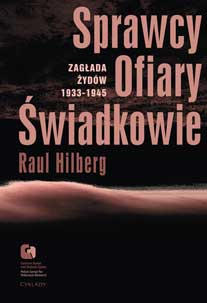 Sprawcy, Ofiary, Świadkowie.
Sprawcy, Ofiary, Świadkowie.
Zagłada Żydów, 1933-1944
Raul Hilberg
Warszawa 2007
Zagłada Żydów. Studia i Materiały
R. 2006, nr. 2; Warszawa 2006
"Jestem Żydem, chcę wejść!".
Hotel Polski w Warszawie, 1943.
Agnieszka Haska
Warszawa 2006
Zagłada Żydów. Studia i Materiały
R. 2005, nr. 1; Warszawa 2005
.jpg) 'Ja tego Żyda znam!'
'Ja tego Żyda znam!'
Szantażowanie Żydów w Warszawie, 1939-1943.
Jan Grabowski
Warszawa 2004
 'Szanowny panie Gistapo!'
'Szanowny panie Gistapo!'
Donosy do władz niemieckich w Warszawie i okolichach, 1940-1941
Barbara Engelking, Warszawa 2003
aaa
 Zagłada Żydów.
Zagłada Żydów.
Studia i Materiały
nr 18, R. 2022
Warszawa 2022
 PAMIĘTNIK
PAMIĘTNIK
Kalman Rotgeber
oprac. Aleksandra Bańkowska, wstęp Jacek Leociak
Warszawa 2021
Zagłada Żydów.
Studia i Materiały
nr 17, R. 2021
Warszawa 2021
 NIE WIEMY CO PRZYNIESIE NAM KOLEJNA GODZINA ...
NIE WIEMY CO PRZYNIESIE NAM KOLEJNA GODZINA ...
Dziennik pisany w ukryciu w latach 1943-1944
Moszek Baum, oprac. Barbara Engelking, tłum. z jidysz Monika Polit
Warszawa 2020
Zagłada Żydów.
Studia i Materiały
nr 16, R. 2020
Warszawa 2020
.jpg) Aryjskiego Żyda wspomnienia, łzy i myśli
Aryjskiego Żyda wspomnienia, łzy i myśli
Zapiski z okupacyjnej Warszawy
Sewek Okonowski, oprac. Marta Janczewska
 PISZĄCY TE SŁOWA JEST PRACOWNIKIEM
PISZĄCY TE SŁOWA JEST PRACOWNIKIEM
GETTOWEJ INSTYTUCJI ...
'z Dziennika' i inne pisma z łódzkiego getta
Józef Zelkowicz, tłum. z jidysz, oprac. i wstęp. Monika Polit
Warszawa 2019
CZYTAJĄC GAZETĘ NIEMIECKĄ ...
Dziennik pisany w ukryciu w Warszawie w latach 1943-1944
Jakub Hochberg, oprac. i wstępem opatrzyła Barbara Engelking
Warszawa 2019
Zagłada Żydów.
Studia i Materiały
nr 15, R. 2019
Warszawa 2019
.jpg) Zagłada Żydów.
Zagłada Żydów.
Studia i Materiały
nr 14, R. 2018
Warszawa 2018
 DALEJ JEST NOC. Losy Żydów w wybranych powiatach okupowanej Polski
DALEJ JEST NOC. Losy Żydów w wybranych powiatach okupowanej Polski
red. i wstęp Barbara Engelking, Jan Grabowski
Warszawa 2018
 ŻADNA BLAGA, ŻADNE KŁAMSTWO ...
ŻADNA BLAGA, ŻADNE KŁAMSTWO ...
Wspomnienia z warszawskiego getta
Stanisław Adler, oprac. i wstępem opatrzyła Marta Janczewska
Warszawa 2018
 Zagłada Żydów.
Zagłada Żydów.
Studia i Materiały
nr 13, R. 2017
Warszawa 2017
 TYLEŚMY JUŻ PRZESZLI ...
TYLEŚMY JUŻ PRZESZLI ...
Dziennik pisany w bunkrze (Żółkiew 1942-1944)
Clara Kramer, oprac. i wstępem opatrzyła Anna Wylegała
Warszawa 2017
 WŚRÓD ZATRUTYCH NOŻY ...
WŚRÓD ZATRUTYCH NOŻY ...
Zapiski z getta i okupowanej Warszawy
Tadeusz Obremski, oprac. i wstępem opatrzyła Agnieszka Haska
Warszawa 2017
 PO WOJNIE, Z POMOCĄ BOŻĄ, JUŻ NIEBAWEM ...
PO WOJNIE, Z POMOCĄ BOŻĄ, JUŻ NIEBAWEM ...
Pisma Kopla i Mirki Piżyców o życiu w getcie i okupowanej Warszawie
oprac. i wstępem opatrzyła Barbara Engelking i Havi Dreifuss
Warszawa 2017
 Zagłada Żydów.
Zagłada Żydów.
Studia i Materiały
nr 12, R. 2016
Warszawa 2016
.jpg) SNY CHOCIAŻ MAMY WSPANIAŁE ...
SNY CHOCIAŻ MAMY WSPANIAŁE ...
Okupacyjne dzienniki Żydów z okolic Mińska Mazowieckiego
oprac. i wstępem opatrzyła Barbara Engelking
Warszawa 2016
 Zagłada Żydów.
Zagłada Żydów.
Studia i Materiały
nr 11, R. 2015
Warszawa 2015
 Mietek Pachter
Mietek Pachter
UMIERAĆ TEŻ TRZEBA UMIEĆ ...
oprac. B. Engelking
Warszawa 2015
 Zagłada Żydów.
Zagłada Żydów.
Studia i Materiały
nr 10, t. I-II, R. 2014
Warszawa 2015
 OCALONY Z ZAGŁADY
OCALONY Z ZAGŁADY
Wspomnienia chłopca z Sokołowa Podlaskiego
tłum. Elżbieta Olender-Dmowska
red .B. Engelking i J. Grabowski
Warszawa 2014
 ZAGŁADA ŻYDÓW. STUDIA I MATERIAŁY
ZAGŁADA ŻYDÓW. STUDIA I MATERIAŁY
vol. 9 R. 2013
Pismo Centrum Badań nad Zagładą Żydów IFiS PAN
Warszawa 2013
 ... TĘSKNOTA NACHODZI NAS JAK CIĘŻKA CHOROBA ...
... TĘSKNOTA NACHODZI NAS JAK CIĘŻKA CHOROBA ...
Korespondencja wojenna rodziny Finkelsztejnów, 1939-1941
oprac. i wstępem opatrzyła Ewa Koźmińska-Frejlak
Warszawa 2012
Raul Hilberg
PAMIĘĆ I POLITYKA. Droga historyka Zagłady
tłum. Jerzy Giebułtowski
Warszawa 2012
 Monika Polit
Monika Polit
"Moja żydowska dusza nie obawia się dnia sądu."
Mordechaj Chaim Rumkowski. Prawda i zmyślenie
Warszawa 2012
.jpg) Dariusz Libionka i Laurence Weinbaum
Dariusz Libionka i Laurence Weinbaum
Bohaterowie, hochsztaplerzy, opisywacze. Wokół Żydowskiego Związku Wojskowego
Warszawa 2011
.jpg) Zagłada Żydów.
Zagłada Żydów.
Studia i Materiały
R. 2011, nr. 7; Warszawa 2011
.jpg) Jan Grabowski
Jan Grabowski
JUDENJAGD. Polowanie na Żydów 1942.1945.
Studium dziejów pewnego powiatu
Warszawa 2011
.jpg) Stanisław Gombiński (Jan Mawult)
Stanisław Gombiński (Jan Mawult)
Wspomnienia policjanta z warszawskiego getta
oprac. i wstęp Marta Janczewska
Warszawa 2010
Holocaust Studies and Materials
Journal of the Polish Center for Holocaust Research
Warssaw 2010
.jpg) Żydów łamiących prawo należy karać śmiercią!
Żydów łamiących prawo należy karać śmiercią!
"Przestępczość" Żydów w Warszawie, 1939-1942
B. Engelking, J. Grabowski
Warszawa 2010
Zagłada Żydów.
Studia i Materiały
R. 2010, nr. 6; Warszawa 2010
Wybór źródeł do nauczania o zagładzie Żydów
Ćwiczenia ze źródłami
red. A. Skibińska, R. Szuchta
Warszawa 2010
.jpg) W Imię Boże!
W Imię Boże!
Cecylia Gruft
oprac. i wstęp Łukasz Biedka
Warszawa 2009
Zagłada Żydów.
Studia i Materiały
R. 2009, nr. 5; Warszawa 2009
.jpg) Żydzi w powstańczej Warszawie
Żydzi w powstańczej Warszawie
Barbara Engelking i Dariusz Libionka
Warszawa 2009
 Reportaże z warszawskiego getta
Reportaże z warszawskiego getta
Perec Opoczyński
Warszawa 2009
 Notatnik
Notatnik
Szmul Rozensztajn
Warszawa 2008
.jpg) Holocaust
Holocaust
Studies and Materials.
English edition
2008, vol. 1; Warsaw 2008
.jpg) Źródła do badań nad zagładą Żydów na okupowanych ziemiach polskich
Źródła do badań nad zagładą Żydów na okupowanych ziemiach polskich
Przewodnik archiwalno-bibliograficzny
Alina Skibińska, wsp. Marta Janczewska, Dariusz Libionka, Witold Mędykowski, Jacek Andrzej Młynarczyk, Jakub Petelewicz, Monika Polit
Warszawa 2007
Zagłada Żydów. Studia i Materiały
R. 2007, nr. 3; Warszawa 2007
Prowincja noc.
Życie i zagłada Żydów w dystrykcie warszawskim
Warszawa 2007
.jpg) Utajone miasto.
Utajone miasto.
Żydzi po 'aryjskiej' stronie Warszawy [1941-1944]
Gunnar S Paulsson
Kraków 2007
 Sprawcy, Ofiary, Świadkowie.
Sprawcy, Ofiary, Świadkowie.
Zagłada Żydów, 1933-1944
Raul Hilberg
Warszawa 2007
Zagłada Żydów. Studia i Materiały
R. 2006, nr. 2; Warszawa 2006
"Jestem Żydem, chcę wejść!".
Hotel Polski w Warszawie, 1943.
Agnieszka Haska
Warszawa 2006
Zagłada Żydów. Studia i Materiały
R. 2005, nr. 1; Warszawa 2005
.jpg) 'Ja tego Żyda znam!'
'Ja tego Żyda znam!'
Szantażowanie Żydów w Warszawie, 1939-1943.
Jan Grabowski
Warszawa 2004
 'Szanowny panie Gistapo!'
'Szanowny panie Gistapo!'
Donosy do władz niemieckich w Warszawie i okolichach, 1940-1941
Barbara Engelking, Warszawa 2003
aaa
Nowy Swiat St. 72, 00-330 Warsaw; POLAND;
Palac Staszica room 120
e-mail: centrum@holocaustresearch.pl
Review of Timothy Snyder's, Black Earth by Jan Grabowski
Review of Timothy Snyder's, Black Earth by Jan Grabowski
07.03.2016 14:49:45
Prof. Jan Grabowski in latest edition of Center's journal "Zaglada Zydow. Studia i Materialy / Holocaust Studies and Materials" reviews widely discussed work of Timothy Snyder, Black Earth. The Holocaust as History and Warning
Jan Grabowski
University of Ottawa
Timothy Snyder, Black Earth. The Holocaust as History and Warning, The Duggan Books, NY, 2015, 462p.
.jpg) Timothy Snyder, a professor at Yale University, is well known to people interested in the history of the 20th century. His previous book “Bloodlands”, published in a dozen languages, has been well-reviewed in popular press and won several important prizes. Nevertheless, among specialists, the book raised considerably less enthusiasm and provoked mixed feelings. Some historians complained of quasi-total disregard of the causal influence of the antisemitic ideology on the Nazi politics of Endlosung. Snyder’s critics also drew attention to the “relativistic” trap, which seeks to equate the fate of the Jews with the many horrors which befell other nations living in the same unhappy neighborhood known as Eastern Europe and referred to by Snyder as “bloodlands”. Snyder’s most recent book: “Black Earth” can be seen as a continuation of and, at the same time, an expansion on many threads and themes known from the “Bloodlands”. First of all, the author remains true to the same geographical area - the narrative is firmly rooted within the realities of “Bloodlands”: in Poland, in the Baltic countries, in the Ukraine, Belorussia and on the periphery of the Soviet Union. It is once again geography which, to a large extent, determines the human fate: the local populations perish together with the states which could have offered them a measure of protection and security. The issue of “destroyed states” is so central to Snyder’s narrative that we will have to deal with it later at length.
Timothy Snyder, a professor at Yale University, is well known to people interested in the history of the 20th century. His previous book “Bloodlands”, published in a dozen languages, has been well-reviewed in popular press and won several important prizes. Nevertheless, among specialists, the book raised considerably less enthusiasm and provoked mixed feelings. Some historians complained of quasi-total disregard of the causal influence of the antisemitic ideology on the Nazi politics of Endlosung. Snyder’s critics also drew attention to the “relativistic” trap, which seeks to equate the fate of the Jews with the many horrors which befell other nations living in the same unhappy neighborhood known as Eastern Europe and referred to by Snyder as “bloodlands”. Snyder’s most recent book: “Black Earth” can be seen as a continuation of and, at the same time, an expansion on many threads and themes known from the “Bloodlands”. First of all, the author remains true to the same geographical area - the narrative is firmly rooted within the realities of “Bloodlands”: in Poland, in the Baltic countries, in the Ukraine, Belorussia and on the periphery of the Soviet Union. It is once again geography which, to a large extent, determines the human fate: the local populations perish together with the states which could have offered them a measure of protection and security. The issue of “destroyed states” is so central to Snyder’s narrative that we will have to deal with it later at length.
Unlike the studies written by Raul Hilberg, Christoper Browning, Saul Friedlander, Peter Longerich and Martin Gilbert, “Black Earth” is rather a flowing, meandering, historical essay where one would look in vain for an exhaustive discussion of the Holocaust. The book opens with a brief presentation of Hitler’s world view, his obsession with the “world Jewish conspiracy” and the resultant need for a Lebensraum for the German master-race. The struggle for the “living space” (located in the half-mythical “East”) was to erupt in a direct confrontation - as Hitler thought - with the “world Jewry and its lackeys”; foremost among them- the Soviet Union. The following chapters discuss at length the place of the “Jewish question” on the pre-war international diplomatic stage, with particular stress placed on the policies of the Polish Foreign Office. The most important - and most coherent - part of the book deals with the Nazi doctrine of “state destruction” as a necessary means to achieve the goal of total domination of Germanic race on the European (and later, presumably, on the world) stage. The description of the destruction of the states begins with Austria, followed by Czechoslovakia through Poland and - after the attack on the Soviet Union - extends to the rest of the Slavic East, and the Baltic countries. The destruction of the states went hand in hand - Snyder argues - with the destruction of the Jews. And the degree of efficiency of the German plans of extermination was directly linked to the degree of destruction of the structures of the conquered states.
It is precisely in these areas that the American historian begins his discussion of “double state destruction” and “double occupation” - referring to the eastern parts of the II Polish Republic as well as to Latvia, Lithuania and Estonia which first found themselves under the Soviet occupation and later, in the summer of 1941, were occupied by the Germans. In these areas former communists and the agents of the Soviet terror apparatus of yesterday, eagerly embraced the German policies of extermination. “As in the doubly-occupied lands, in the pre-war Soviet Union Jews were sacrificed” - writes Snyder - “ for the holy lie of the collective innocence of others” (181). In other words, it was not the local Belorussians, Poles, Ukrainians or Lithuanians who had to pay for their previous collaboration with the Soviets, but the Jews. The killing of the Jews was, therefore, instrumental on various levels: it allowed the locals to avoid responsibility for the recent past, it enabled them to curry favor with the new German masters and, last but definitely not least, it sealed and finalized the earlier theft of Jewish property. The term “double destruction of the state” allows Snyder to discuss at length the mass murder of the Jewish populations at the hands of the Einsatzgruppen, the police and their local helpers. This part of the Shoah, is known in the Western historiography as “Holocaust by bullets” - a term introduced by Patrick Desbois, to whom, surprisingly, Snyder, makes no reference. The author stresses that mass shootings which took place behind at the rear of the advancing German armies, claimed over one million victims; that the executions were happening in public and made hundreds of thousands German soldiers (and their families) aware of and complicit in the Nazi policies of extermination.
The subsequent chapters trace the different reasons which influenced people and institutions which helped (or refused to help) the Jewish refugees at the time of need. The final chapter entitled “Our World” makes an attempt to look at the dangers facing humanity today and seeks lessons from the Shoah.
Monocausality of the reasons of the Shoah
Both “Bloodlands” and “Black Earth” are written in an engaging prose and will, undoubtedly, attract many readers. Their success is also due to the simplicity of the arguments which provides the readers, even those without broader knowledge of history, with a universal key which can unlock the complexities of the past. In the case of “Black Earth” this universal key to understanding of the Holocaust is the previously mentioned concept of the “destruction of the states”. Most of us (not to mention the specialists) need not to be reminded that the German mechanisms of terror known from Eastern Europe, cannot even be compared with the relatively benign occupation regimes established in the West. One can take it further: the vast majority of readers are well aware of the fact that, during the war, many countries found themselves under the German occupation, with everything it entailed. But it is precisely this unsurprising thesis which the author of “Black Earth” strives to prove in his book.
“Black Earth’s” Leitmotiv can be summarized in a few words: “State exists - Jews live; state is gone - Jews perish”. In the areas where the Germans succeeded in destroying the preexistent state structures, the fate of the Jews - argues Snyder - was incomparably worse than that of the Jews living in the still-preserved states. According to Snyder: “Throughout Europe, but to a different degrees in different places, German occupation destroyed the institutions that made ideas of reciprocity seem plausible. Where Germans obliterated conventional states, or annihilated Soviet institutions that had just destroyed conventional states, they created the abyss where racism and politics pulled together towards nothingness”. (p. 319-320).
The expression “destruction of the state” returns in Snyder’s book with troubling frequency - as if to allow even the least perceptive reader to grasp the true message of the book. There are pages on which the expression “destroyed states” (in various forms) appears four, five, or more times! It can be argued that an important argument needs to be restated from time to time, but one can hardly expect to see it repeated a few hundred times! Instead of the nebulous “state destruction” one could simply say that the Germans, wherever they could, introduced a system of governance based on an unprecedented level of terror. And they could do it in these parts of Europe where it was possible to safely disregard the local and the world public opinion, in the areas inhabited by peoples who found themselves at he lowest rungs of the Nazi ladder of “racial respectability”. In other words - in the Slavic east, in Poland and on the territories east of Poland, where the vast majority of Europe’s Jews lived. But such a thesis would, of course, be hardly original, and hence the awkward and relentlessly repeated concept of “destroyed states” served as a founding idea, which provides “Black Earth” with its raison d’être. The “destruction of the states” - according to Snyder - was something unprecedented, it was a radical step which transformed human attitudes. Even if true, is it enough to offer a convincing explanation for the reasons of the destruction of the European Jewry?
To put it in simple terms, the level of terror instituted in the public sphere by the Germans provides much more convincing argument than the abstract notion of ”destroyed state” Occupied Poland, known at the time as the Generalgouvernement (GG), is a case in point. True, at the end of 1943 and in early 1944 the situation in the Generalgouvernement evolved towards anarchy but, in the spring, summer and fall of 1942, when Germans emptied the ghettos and deported 1.5 million Polish Jews to extermination camps, occupied Poland was far from being a disorganized, stateless entity. Despite the terror and violence (which should not be mistaken with the abstract notion of “destroyed state”), workers toiled in factories, doctors saw patients, people paid taxes and rents, police regulated traffic, courts heard criminal and civil cases, and theatres were packed full with move-goers. What was then the influence of the “destruction of the state” on the fate of the Jews? The abstract notion of “destroyed state” cannot accunt for the success of the German genocidal project. The level of terror combined with popular complicity based on pre-war and war-time antisemitism can, however, offer a more convincing explanation.
Given Snyder’s insistence on the explanatory value of the thesis of “state destruction”, it comes as no surprise that the author uses it to explain both the complete extermination of the Jews of Estonia (1941) and the preservation of the Jews of Danemark (1943). The fact that the rescue of Danish Jewry had more to do with the individual initiatives of normal Danes than with the structures of the Danish state, seems to be lost on the author. Conversely, the extermination of the Jews of Estonia was most likely not related to the “disappearance of the state” but had all to do with the degree of terror instituted in the public sphere by the Germans. The same thesis (“partial destruction of the structures of the Dutch state”) should, according to Snyder, explain the extremely high - in West-European context - percentage of Jews murdered in Holland. This issue, however, is far less obvious than Snyder would like us to believe. The question of the attitudes of the Dutch society to the persecution of Jews is a hotly debated issue today in Holland but the arguments put forward by historians such as Bart van der Boom, Pim Griffioen, Christina Morina or Remco Ensel are much more nuanced and complex than the readers of “Black Earth” are being led to believe. The author invokes his thesis about the survival and non-survival of Jews where it holds some water and there where it definitely has no application. As, for instance, in the case of Jewish women fleeing occupied Poland and seeking refuge, as forced laborers, in Germany. According to Snyder, “the fact that the Nazi Germany was a state attracted Jewish women from the east”. Wrong. What drove the desperate Jewish women fleeing Poland was not the anticipated protection of the German state but the paralysing fear of enterprising Polish “Aryans” who could, without difficulty, recognize Jews and betray them to the Germans. At the same time, the Germans, in Germany, had hardly any experience in “telling” a Jew from non-Jew.
The second “interpretative key” of “Black Earth” is linked to the previously mentioned concept of double occupation”, or “double destruction of the state”. In these areas, claims the author, the former agents of the Soviet regime and the pro-Soviet collaborators became particularly involved in the mass-murder of Jews. Blaming the Jews (and murdering them) enabled the locals to shed the responsibility for their previous complicity with the Soviets. Membership of the various pro-German militias was - according to Snyder - composed in large part of former Soviet lackeys busily covering their tracks. In some cases - Jedwabne, for instance - there is some evidence which could corroborate Snyder’s assertions but the scale of this phenomenon was limited and should definitely not be generalized. The policemen in question simply served the changing authorities: such is the nature of their profession that every regime requires their services. It is, therefore, not surprising that certain number of Lithuanian or Latvian policemen first served their independent countries, later worked for the Soviets and, in 1941, offered their services to the Germans. Was it, however, a general trend - as implied by Snyder who, once again, makes reference to the concept of the “double destruction of states”? At the present stage of research one cannot make such a claim and the works of Christoph Dieckmann, Martin Dean, Saulius Suziedelis or Jarred McBride do not confirm Snyder’s assertions. In fact, a brief overview of personnel files of “eastern” volunteers for the Schutzmannschaftsbatallions indicates quite the opposite: majority of the candidates for the German auxiliary police was recruited among the young and very young peasants without earlier communist “episodes”, or links to the Soviets. Most likely, they joined the Germans to flee the misery and poverty of their every-day life. In the end Snyder admits himself that, from the Jewish standpoint, it mattered little whether a given area belonged to the zones of “single” or “double destruction of the state”: in one case as well as the other practically all Jews have been murdered.
It is within this context that Snyder claims that the populations living in the “zones of the double-destruction of the state” and in the conquered parts of the Soviet Union were most likely to take part in the implementation of German policies of extermination. In contrast “In occupied Poland, the Holocaust began more than two years after the German invasion and was largely isolated from the local population. In the occupied Soviet Union, the killing of Jews took place in the open air, in front of the population, with the help of young male Soviet citizens” (150). Snyder is wrong. The few closed ghettos (such as Warsaw or Cracow) were exceptions - and even in these cases the contacts with the “Aryan” side were frequent and multiple. The majority of Polish Jews, however, were removed into half-open or open ghettos where the only real physical barrier separating them from the “Aryan side”consisted of wooden fences or barbed wire, both easily breached. The real borders of the ghettos were in the minds of the gentiles, who enforced (with great efficiency) and helped to enforce the restrictions placed by the Germans on Jews. To makes Snyder’s assertion even more implausible, hundreds of thousands of Polish Jews were resettled into the ghettos only in the spring and in the summer of 1942, on the eve of the implementation of the final solution. For these reasons there can be no question about the isolation of the Jews from the rest of the society. What is more important, the liquidations of hundreds of ghettos across Poland (Germans referred to them as “Aktionen”) occurred in the midst of Polish towns and cities and millions of Poles witnessed the destruction of Jewish communities. The Aktionen became scenes of unprecedented and hitherto unknown violence during which the streets of Polish cities, quite literally, run with blood. The local population has only been witnessing these events, but many became directly involved in German genocidal plans, and contributed to the deaths of their Jewish neighbors. Untold thousands of “bystanders” accompanied Jews on their last trip to the death trains, thousands more took part in the feverish searches of the recently emptied ghettos, stealing the Jewish property and pulling the hidden Jews out of their hideouts and bunkers. The “bystanders” worked hand in hand with the “blue” policemen, the firefighters and the yunaks from the Construction Service (Baudienst). Even a hasty overview of the Jewish testimonies from places such as Tarnów, Działoszyce, Miechów, Dąbrowa, Szczebrzeszyn, Węgrów, Stoczek, Sokołów, Siedlce,to name but a few, provides ample and undeniable proof that the Holocaust in Poland was definitely not “isolated from the local population” - as claimed by the author of “Black Earth”.
In the chapter “The Auschwitz Paradox”Snyder takes issue with the “myth of Auschwitz”, a ritual of celebration and commemoration which is being performed to the detriment of the historical truth about the Shoah. Indeed, for many, especially in Western Europe and in North America, Auschwitz remains one of the few (if not the only) points of reference symbolizing the Holocaust. One cannot but agree with Snyder who writes: “Auschwitz has also become the standard shorthand of the Holocaust because, when treated in a certain mythical and reductive way, it seems to separate mass murder of Jews from human choices and actions. Insofar as the Holocaust is limited to Auschwitz, it can be isloated from most of the nations it touched as well as from the landscapes it altered”. Indeed, Auschwitz has become an explanatory device, a passe-partout which entered the public imagination and which allows for easy generalizations and for the “taming” of the Holocaust.
While one can agree with Snyder that too much focus on Auschwitz can lead to an opaque, myopic and flawed perception of the Shoah, the quasi-complete absence of any substantial discussion of Aktion Reinhardt in his own book is hard to explain and even more difficult to accept. As it is, the extermination camps in Beżłec, Majdanek, Sobibór and Treblinka (sites where 1.5 million Jews have been put to death) have, for all practical purposes, been removed from Snyder’s account. Readers of “Black Earth” would look in vain for any substantial discussion of Treblinka- a place where nearly one million have been killed. The name “Treblinka” is being mentioned in the book eight times but practically all of these references are peripheral to the issue and carry little, or no informative value. Can one write about the Holocaust (especially in the context of the occupied East) and leave out Treblinka? Incidentally, the extermination camps in Bełżec and Sobibór, sites of respectively 500.000 and 150.000 Jewish deaths, are treated in the book with an even greater insoucience than Treblinka and are hardly mentioned at all. Can one write about the Holocaust in the East and leave out these “primitive, but efficient production lines of death” - as described by SS-Untersturmführer Franz Suchomel in his interview with Claude Lanzmann?
Problems with structure
“Black Earth” is a book which, throughout the text strives, with a limited degree of success, to find its own rhythm and sense. One can question, for instance, the great stress placed by the author on the interwar diplomacy (chapters “Berlin, Warsaw, Moscow” and “The Promise of Palestine”). It is far from clear what exactly is the importance of this part of the narrative on the subsequent fate of the Jews? It seems that the author, who has earlier read many interesting things, is now eager to share them with his readers - even if his previous readings are only remotely related with the discussed topic. For reasons which are obscure to the author of this review, the author of “Black Earth” devotes considerable effort and space to describe and to discuss the short-lived (and, to be honest, altogether inconsequential) help given by the Polish Foreign Office to Jewish nationalists during the 1937-39 period. The Poles gave their support to Irgun fighters in hope that the latter would create a Jewish state in the Palestine, which in turn would trigger an exodus of Polish Jews to the Promised Land and, therefore, bring closer their dream of Poland free of the Jews. The author returns to discuss this ephemerid activity (well known to Polish historians, and often discussed in the Polish historical literature, one might add) throughout the book. Wiktor Tomir Drymmer, a diplomat responsible for contacts with Irgun, makes appearance in the book on nine different occasions, which makes him more prominent than the previously mentioned death camps of Aktion Reinhard. For those who would like to know even more about Drymmer, I can only add that after the war the Polish official established himself in Canada, where he turned to carpentry and on this field he achieved more successes than in the realm of diplomacy.
Similar reservations about the coherence and structure of the text come to mind while reading the closing chapters of the book which touch upon the issue of rescue of Jews in the Holocaust.
In this case, Snyder calls upon many Jewish testimonies from collection 301 of the Jewish Historical Institute in Warsaw, interviews with survivors from the databases of the US Holocaust Museum in Washington and from the YIVO archives. These testimonies are fascinating and, as the scholars of the Holocaust know well, they are among the most touching and moving documents of the period. And the choice is rich: in Warsaw alone there are seven thousand of these “early testimonies”, collected from Jewish survivors, during the 1944-47 period, by the local Jewish Committees. It is altogether unclear, however, what were the selection criteria which guided the author of “Black Earth” in his choices. Although from time to time the author draws our attention to the impact of the “state destruction” upon the fate of the quoted Jewish witnesses, it seems as if the testimonies found their way to the book (just as did Drymmer and the Polish Foreign Office) more by accident then by design.
The last chapter (“Conclusion: Our World”) is moralistic and prophetic, and carries a warning for humanity. According to Snyder, Hitler’s vision of the world was inherently linked to the destruction of European Jewry, seen as an impediment to the final triumph of the Germanic race. The removal of the Jews - argues Snyder - would allow the Germans to access the unlimited food supplies in the mythical East and enabled further strengthening of the Volksgemeinschaft. Now, in the second decade of the XXI century- writes the American historian - the world faces similar threats, although related to a different kind of danger: the global warming. “The expected increase of average global temperatures by four degrees Celsius this century would transform human life on much of the globe. Climate change” - pontificates the author of “Black Earth” - “is unpredictable”. “If ice sheets collapse, heat from the sun will be absorbed by seawater rather than reflected back into space. If the Siberian tundra melts, methane will rise from the earth...”.
In the face of the approaching climatic Armageddon we should, warns Snyder, remember about the lessons of the Shoah. To quote once again from the final chapter of the book: “Perhaps the experience of unprecedented storms or relentless droughts will jar expectations about the security of basic resources and make Hitlerian politics more resonant”.
Michael Marrus, one of the most eminent scholars of the Holocaust once observed: “...every historical event and every individual is unique, in that each is different from any other. Unlike social scientists, who search for generalities, historians are especially aware of such uniqueness, and indeed specialize in discerning those elements that make a particular event or society or individual unlike another. Normally, their focus is on the particular rather than the general. Historians study a revolution, rather than revolutions; a war, rather than warfare; and the Holocaust rather than genocide. Naturally, historians have their ideas about the latter, but they do not usually earn their living by such pronouncements, and I venture to say that these are not the most valued exercises of historical scholars’ time”. What Marrus refers to are not, of course, generalizations associated with historical research, but sweeping observations and hypotheses which have little or no rooting in the presented evidence and which have no obvious links to the discussed issues. One can only regret that Timothy Snyder failed to follow Michael Marrus’ wise advise.
Originally in Polish, in: Zagłada Żydów. Studia i Materiały, vol. 11, Y. 2015, pp. 726-733



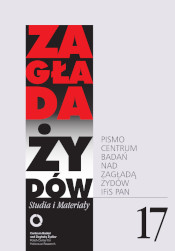

.jpg)
.jpg)


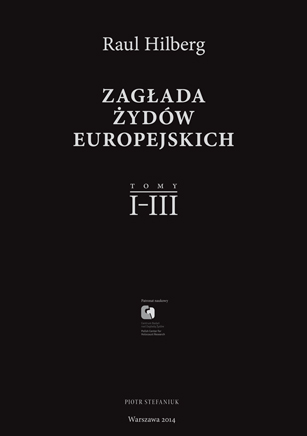
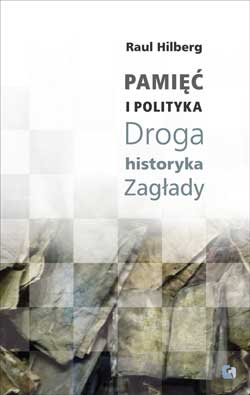
.jpg)
.jpg)
.jpg)
.jpg)
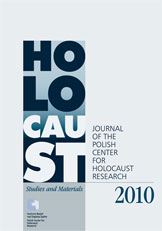

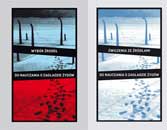
.jpg)
.jpg)
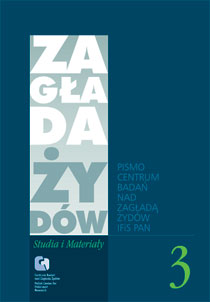
.jpg)
